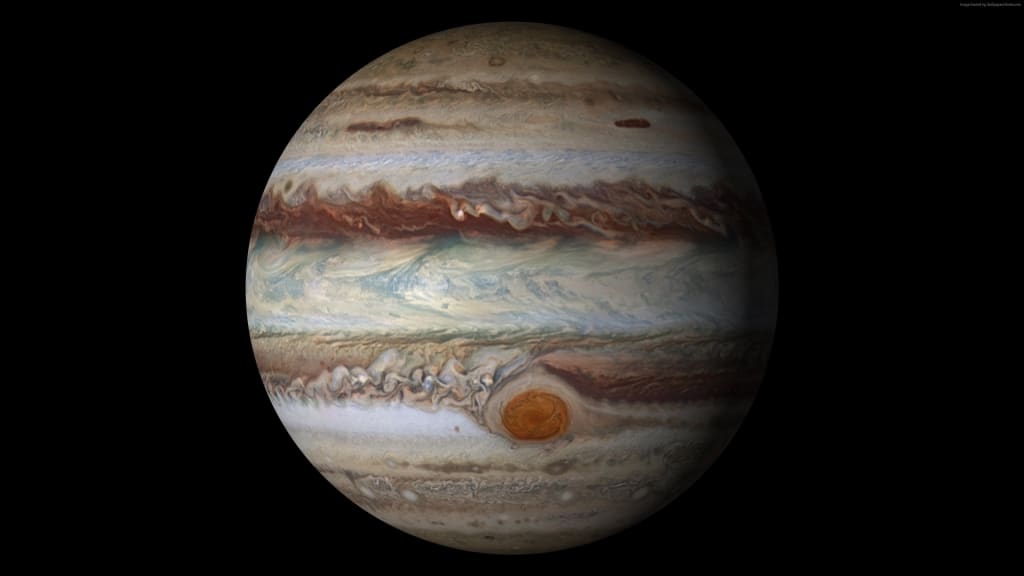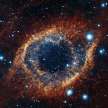
Jupiter is a gas giant planet, meaning that it is primarily composed of hydrogen and helium gas. It is the fifth planet from the Sun and is located between Mars and Saturn. Jupiter is the largest planet in our solar system, with a diameter of approximately 86,881 miles (139,822 kilometers), which is more than 11 times the diameter of Earth.
Jupiter's atmosphere is characterized by colorful bands of clouds, with the most prominent being the Great Red Spot, a massive storm that has been raging for at least 350 years. The atmosphere also contains high-speed winds that can reach up to 400 miles per hour (644 kilometers per hour). These winds are organized into alternating east-west jet streams that circle the planet.
Jupiter's magnetic field is one of the strongest in our solar system, about 20,000 times stronger than Earth's magnetic field. This magnetic field traps charged particles from the solar wind, creating intense radiation belts around the planet. These radiation belts are hazardous to spacecraft and can cause damage to electronic equipment.
Jupiter has a very short day, with one rotation taking just under 10 hours. This rapid rotation causes the planet to bulge at the equator and flatten at the poles. The planet's oblate shape is due to the centrifugal force generated by its rotation.
Jupiter has at least 79 known moons, the four largest of which are called the Galilean moons: Io, Europa, Ganymede, and Callisto. These moons were discovered by Galileo Galilei in 1610 and are some of the largest moons in our solar system. The Galilean moons are of particular interest to scientists because they are believed to have subsurface oceans that could potentially harbor life.
Jupiter has been visited by several spacecraft, including the Pioneer 10 and 11, Voyager 1 and 2, Galileo, and Juno. These missions have provided valuable information about the planet's atmosphere, magnetic field, and moons. The Juno mission, which arrived at Jupiter in 2016, is currently studying the planet's interior structure, gravity field, and magnetic field in unprecedented detail.
JUPITER IN ANCIENT HISTORY
In Roman mythology, Jupiter was the king of the gods and the god of the sky and thunder. He was often depicted holding a lightning bolt and was associated with the eagle, which was considered a symbol of power and strength. The planet Jupiter was named after this Roman god.
In Greek mythology, Jupiter was known as Zeus, the king of the gods and the god of the sky and thunder. He was also associated with the eagle and was often depicted holding a thunderbolt. The planet Jupiter was also known as Zeus in ancient Greece.
In Hindu mythology, Jupiter was known as Brihaspati, the guru of the gods and the god of wisdom and knowledge. He was often depicted riding a chariot pulled by eight horses and was associated with the color yellow.
In ancient Babylonian astronomy, Jupiter was known as Marduk, the god of creation and patron deity of the city of Babylon. The Babylonians were the first to record the motion of Jupiter across the sky and used it to predict the future.
In Chinese astronomy, Jupiter was known as the Wood Star and was associated with the element of wood and the direction of east. It was believed to bring good luck and prosperity.
INTRESTING FACTS
Jupiter is so massive that it actually affects the Sun's orbit. The Sun and Jupiter both orbit around a common center of mass, which is located just above the Sun's surface.
Jupiter's magnetic field is so strong that it can cause auroras on its moons, even though they don't have a magnetic field of their own.
Jupiter has the shortest day of any planet in our solar system, with one rotation taking just under 10 hours.
The Great Red Spot, a massive storm on Jupiter, is so large that it could fit three Earths inside it.
Jupiter's atmosphere is composed mostly of hydrogen and helium, but it also contains small amounts of methane, ammonia, and water vapor.
Jupiter's gravity is so strong that it can cause gravitational disturbances in the orbits of other planets, asteroids, and comets in our solar system.
Jupiter's magnetic field and radiation belts make it a hazardous environment for spacecraft, and any mission to Jupiter must be carefully designed to withstand these conditions.
Jupiter is visible to the naked eye from Earth and has been observed by astronomers for thousands of years.
QUESTIONS WITHOUT ANSWERS
1. What causes the Great Red Spot, and how has it been able to persist for so long?
2. What is the nature of the subsurface oceans on Jupiter's moons, and could they potentially harbor life?
3. How did Jupiter form?
About the Creator
Captain Kidd
I am thrilled to invite you to an extraordinary adventure. A journey through the vast and mysterious realm of outer space, promises to be both educational and awe-inspiring, as we explore the wonders of the cosmos together.
Enjoyed the story? Support the Creator.
Subscribe for free to receive all their stories in your feed. You could also pledge your support or give them a one-off tip, letting them know you appreciate their work.






Comments
There are no comments for this story
Be the first to respond and start the conversation.